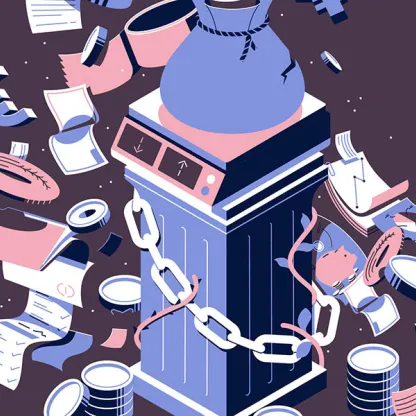May wasn't short of market-moving news - much of it about tariffs. In response, investor sentiment on the US economy soured - and then sweetened (somewhat) again.

Monthly digest: A catalyst-rich environment
Article last updated 10 June 2025.
An investment strategist who recently visited our offices described 2025 as a “catalyst-rich environment” so far. One could certainly not accuse him of exaggeration – there have been thrills and spills aplenty.
But remarkably, as happens with even the most stomach-churning theme park ride, sterling-based balanced portfolio investors have arrived back pretty much where they started the year. Even so, hanging on to what you had has taken some nerve – many investors will have been tempted to get off the ride at the bottom when equities plummeted following President Trump’s ‘Liberation Day’ tariff announcements on 2 April.
But those with stronger nerves or a disciplined investment process (or both) have been rewarded with a strong recovery.
US recession watch
To illustrate the extent of sentiment shifts this year, we’ve been monitoring the probability of a US recession developing in 2025 as generated by the Polymarket betting website. Polymarket doesn’t set odds. Instead, odds are set by how much money Polymarket’s users are prepared to put behind different outcomes.
Although websites that run along these lines are relatively new, they provided quite a good indicator of the fortunes of the candidates in last year’s US presidential race. They also have the merit of being much more responsive to events than, say, consensus forecasts gathered from mainstream economists by organisations such as Bloomberg.
At the beginning of the year, punters were pricing in an 18% probability of a US recession in the following twelve months. The baseline probability is around 14%, based on the fact that, historically, the US has entered a recession once every seven years. That made 18% a fairly neutral starting point, suggesting a relatively carefree future. By March the probability had risen to 40% as concerns rose about both the aggressive federal government cost-cutting programme promised by Elon Musk’s Department of Government Efficiency (Doge) and the looming threat of tariffs.
And then, as we discussed last month, the level of tariffs unveiled at the start of April greatly surpassed any sensible estimates. At that point, the recession odds peaked at 65%.
Where are the odds now? Thankfully, they’ve dropped to just 28%. That’s not to say it’s all blue skies ahead, but investors (or at least the betting variety) have concluded that Donald Trump will not be so reckless as to drive the economy off a cliff. Meanwhile, Musk has left Washington in a huff. Moreover, the weak first-quarter GDP number from the US was somewhat misleading because of the way that imports are accounted for. There was a boom in demand for goods from overseas as everyone rushed to build inventories before they had to pay tariffs. This led to an apparent economic contraction of 0.2%, compared with the final quarter of 2024. However, general consumption and investment held up well.
There are inevitably going to be more distortions in the months ahead, so we’ll have to focus on the underlying situation rather than being distracted by the more volatile headline numbers. If we were to pick out one set of data to concentrate on, it would be employment statistics. For clues, we’ll look at the number of job openings, the propensity of workers to quit their job (which tends to be higher when they’re more confident), the trend of initial jobless claims (which is showing signs of rising) and monthly payroll data.
The Taco trade
Donald Trump has a notoriously poor diet. Tacos can be quite healthy, but much depends on what you put in them. That said, the Taco trade has nothing to do with Mexican food – it’s the latest market-related acronym: ‘Trump always chickens out.’
The term was coined by Financial Times journalist Robert Armstrong to describe the President’s habit of consistently backing away from his worst threats, especially when it comes to tariffs. If a counterparty shows the slightest hint of complying with his demands or offering improved trading terms he tends to walk back. He initiated the tariff pause in response to weak equity and bond markets.
Investors have concluded that this is how things will continue. That doesn’t mean that tariffs will go away, but most probably that the US’ average effective tariff rate on its goods imports will settle somewhere in the low double digits. We’d all prefer to return to the status quo ante, but we can live with that level if it returns us to a stable equilibrium. Investors tend prefer a less than perfect certainty over an uncertain future.
Investor sentiment has also been bolstered by the intervention of the US’ International Court of Trade, which ruled the tariffs illegal. Trump has overreached the powers given to the President by various past Acts of Congress, particularly those related to the International Emergency Economic Powers Act of 1977. This allows the President to impose tariffs by executive order, bypassing congressional approval, in the case of emergencies such as a physical threat to the US itself. But the court declared that no such emergency exists.
As things stand, the US is able to continue to collect the tariffs because the Court of Appeal paused the trade court’s ruling to allow for further investigation. Even so, the initial ruling was taken as a sign that the US democratic system, with all its checks and balances, is fighting back against unconstrained presidential power.
Trump can invoke various other acts to keep his tariff dream alive. One section of the 1962 Trade Expansion Act allows for tariffs on grounds of national security, although this needs evidence. Investigations to provide such evidence are already under way for sectors such as pharmaceuticals, semiconductors, copper and lumber. Potentially, Trump could try to push a bill through Congress allowing him unlimited power to impose tariffs. But that would need a supermajority of sixty votes in the Senate, which appears improbable when the Republicans only have fifty-three seats.
We should also mention one piece of good trade news: the US and UK signed an ‘Economic Prosperity Deal’ (EPD) in May. Its name betrays the fact that it isn’t a Free Trade Agreement or anything close to one. For all the hoopla and political theatre, there are few ‘i’s dotted or ‘t’s crossed and not everyone is happy. For example, the UK’s (two) ethanol producers are up in arms about the intention to remove the UK’s 19% tariffs on imports of ethanol from the US.
One benefit of the EPD is that the UK isn’t subject to the 50% global tariff that Trump imposed on steel imports in a fit of pique in response to the Court of Trade’s ruling. This doubled the initial 25% tariff that he imposed in March. The EPD is supposed to exempt the UK from steel tariffs completely when it comes into force.
We think tariffs are here to stay, but at levels that everyone can learn to live with. We also bear in mind that the clock is ticking down towards the mid-term congressional elections in November 2026. The Republicans will want to promote good news ahead of those polls. Even so, we cannot discount more disruptive announcements over the summer. Trump has a habit of upending things just before striking a deal.
Leaving the reserve?
The recent market volatility has coincided with a weaker dollar, even as dollar bond yields rise and the prospect of deeper interest rate cuts recedes. This is an unusual, although not unprecedented, state of affairs. Observers have long thought the dollar looked expensive on various measures, such as Purchasing Power Parity, a measure of how much the same basket of goods and services would cost in different countries. However, valuation tends to be a poor guide to market timing so this overvaluation has persisted, supported in the last few years by strong flows into US equities.
But dry tinder eventually meets a match. That arrived in the form of President Trump. Investors are questioning their overall exposure to dollar-based assets at a time when confidence in the US is being undermined. The current administration is displaying a general disregard for the institutions that have enabled America’s prosperity, as well as apparent disdain for the Constitution itself. At the same time, developments such as DeepSeek’s breakthrough large language model. unveiled in January, have raised questions about US dominance in artificial intelligence (AI). Having said that, the US’ Magnificent 7 leading technology companies collectively beat first-quarter earnings expectations by the biggest margin since the third quarter of 2023. This helped to restore some confidence in the US stock market.
Another development weighing on the dollar is the passage of the latest budget through Congress. If you were ever in doubt as to the theatrical nature of politics today, the act that needs passing to approve it is called the One Big Beautiful Bill Act (OBBBA)! Beauty is in the eye of the beholder, of course, and there are plenty of observers who find the bill repellent because it perpetuates the growth of the US fiscal deficit, with estimates of the increase in the range of $2.3tn to $3tn over the next decade.
BCA Research calculates that, after allowing for the act, the annual deficit is to remain at 6-8% of GDP over the Trump presidency, a level usually associated with recessions or wars. That will make the interest payments on the country’s liabilities increasingly costly. This is making investors demand a higher yield to account for the greater (if still small) risk of default. Which, of course, increases debt payments even more.
A sting in the tail of the OBBBA is Section 899. This would allow Trump to impose taxes on foreign entities operating in the US if their home country is deemed to have “unfair” or “discriminatory” tax systems, as defined at the Treasury Secretary’s discretion. For example, a Digital Services Tax (as currently implemented by the UK, France and Italy, amongst others) would be deemed to qualify.
The section applies to a wide range of entities, including partnerships, corporations, individuals and government-controlled entities (including sovereign wealth funds and pension funds). Section 899 might just be another negotiating tool to get the bulk of the OBBBA through Congress. But nobody can be sure and so, at the margin at least, the threat of it is reducing overseas demand for dollar assets.
There have been several global reserve currencies over the centuries – currencies widely used in international trade, and in more modern times held by central banks, because they’re regarded as stable stores of value. The first acknowledged one was the Portuguese escudo in the fifteenth and sixteenth centuries. This was followed by the Spanish peso, the Dutch florin and the French franc. Sterling had its turn from 1815 (following the Battle of Waterloo) to 1920 (when the country was effectively bankrupted by World War One). Indeed, global overreach and wealth-sapping wars seem to be something of a theme when it comes to handing over the global reserve currency baton.
The one hundred and five years since 1920 is a long stint. It would not be unusual to see the baton passed again, although there is no obvious candidate. The Chinese yuan is issued by a country with a closed capital account and lack of acceptable governance in the eyes of most global investors. The euro is another potential candidate that has gained ground recently, but is still the common currency of a group of independent countries with no fiscal or banking union and a lack of wider regulatory unity. Nothing else has sufficient capacity to accommodate the potential inflows.
At the margin, gold has been bought by managers of central bank reserves outside the US in recent years. But it also has limited capacity. And nobody seems ready to subject themselves to the discipline of a return to the gold standard, where the currency must be backed by gold reserves of equal value.
In the light of these arguments, we might see some portfolio rebalancing in favour of other currencies, with Europe the favoured destination owing to its renewed focus on growth through (more affordable) fiscal stimulus. And our long-term Capital Market Assumptions already bake in an unwinding of the dollar’s overvaluation relative to sterling over the next decade. But it still appears premature to call the end of the dollar’s global reserve currency status.
Fixed income: reassurance needed
The Bloomberg Global Aggregate Bond Index is up 5.8% so far this year, flattered by the weakness of the dollar. The sterling hedged version has returned 2%. All the return has come from the interest ‘carry’, with no extra capital gains to speak of. Global bond investors continue to act nervously, although they are being constantly reassured by policymakers.
Even so, the fact that policymakers have to keep doing that is worrisome in itself. US Treasury Secretary Scott Bessent appeared on television to spell out that the US was not going to default on its debt following bearish comments from the CEO of JPMorgan Chase, Jamie Dimon, perhaps the most influential person in US finance outside the government.
Both Japan’s Ministry of Finance and the UK’s Debt Management Office have had to reweight their government debt issuance in favour of shorter-dated issues to relieve the pressure at the long end of the market.
We note that the OECD, the intergovernmental organisation formed to promote growth among member states, sent a warning shot to UK Chancellor Rachel Reeves in its quarterly global health check. It argued that she might need to raise taxes (again) to keep the UK’s fiscal house in order.
With populist political parties in the ascendant in many countries, making politicians unwilling to return to fiscal austerity, we think that market participants will regularly be forced to rein back politicians’ promises of fiscal largesse by forcing bond yields higher. And in a fight between politicians and bond markets, the bond markets tend to win. Ask Liz Truss.
All UK Conventional Gilts have delivered a total return of -0.1% over the last three months and +1.8% over the last year. Index-Linked Gilts returned -3.0% and -7.2% over the same periods. Emerging Market bonds produced a total return of 1.1% in sterling over the three months to end-May (+11.1% over 12m). Global High Yield bonds delivered -1.11% (+8.9% over 12m) in sterling terms.
Outlook: the marvellous and the manic
These continue to be challenging times for investors, with periodic bouts of high volatility testing everyone’s nerves. Various indices that attempt to measure uncertainty are at all-time highs. But the fact that they’re higher than during the Global Financial Crisis and even the peak of the Covid crisis makes one wonder how accurate a measure they are. That could reflect today’s media environment, and the self-reinforcing nature of sentiment as reflected back by the algorithms that drive much of the content that we see today. It’s not called ‘doomscrolling’ for nothing!
And yet we continue to marvel at technological progress and the gains in productivity that are promised by AI. A well-known technology fund manager recently reminded us that today’s AI applications are the worst and most clunky we will ever see. Think AOL dial-up internet for a comparison.
And while we still cannot be sure where exactly the benefits (and potential harms) might land, we believe that the outlook for corporate profitability will ultimately be enhanced.
One hopes that social equilibrium will also be maintained. But that might be a bigger challenge for governments that are already under pressure from many sides, including the challenges of spending on social benefits when government finances are challenged by low economic growth and the need to spend more on defence.




